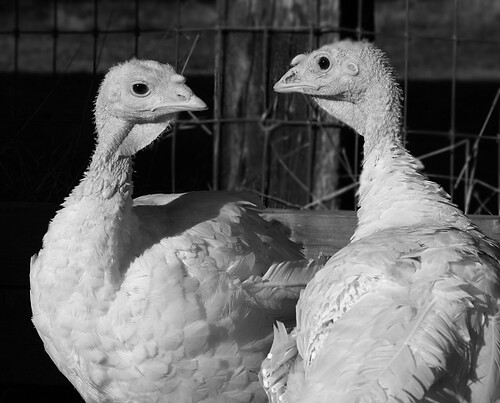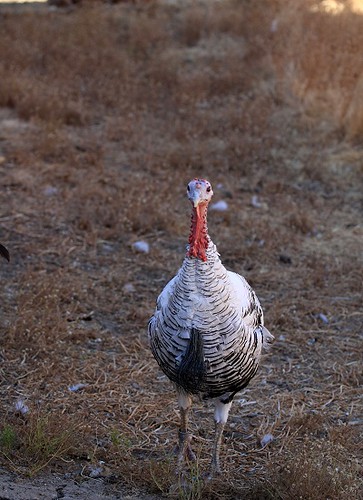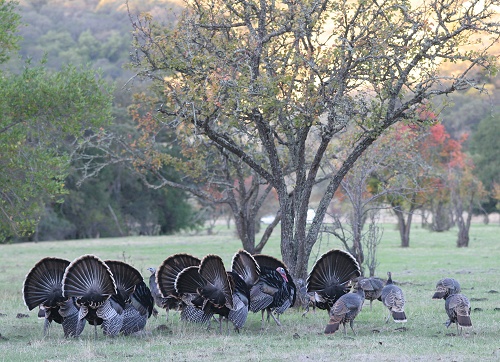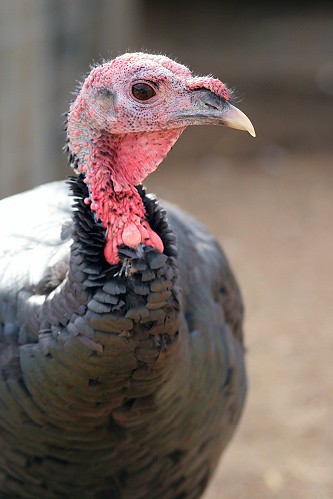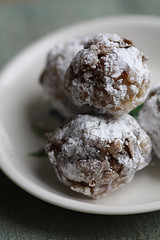From now until Thanksgiving, it's all about the turkeys who call Animal Place sanctuary home. As you meet the turkeys, I hope you will reconsider the main course for the upcoming holiday. To help you, I'll be adding recipes and purchase suggestions at the end of each post. All of these entries are in honor of the turkeys not lucky enough to end up at a sanctuary...spare them a thought this holiday.
------------------------------------------------------------------------------------------------------------
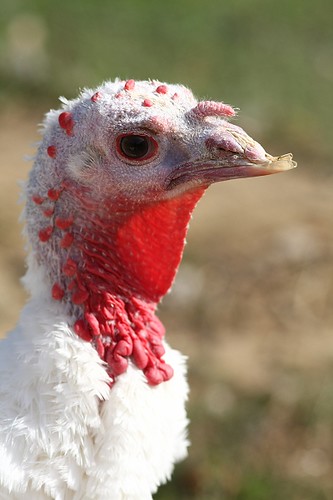
When I am in the mood to idolize turkeys, I think of Margaret. (According to Jamie, our animal care manager, one should
always be in the mood to worship turkeys. She says they look like little angels.)
When I think of one reason why everyone should stop eating turkeys, I think of Margaret.
Margaret came to Animal Place in April of 2004 with eleven other poults. They were rescued from a breeding farm.
White breasted turkeys cannot mate naturally. They are too large, victims of an industry that favors large breasts and abnormal size over animal welfare.
All broad white and bronze breasted turkeys are artificially inseminated.
Margaret is the very first turkey I met. Ever. I was volunteering at Animal Place, trying to find my place in a world that simply didn't value or appreciate cows and pigs the way I did. Animal Place gave me hope, so much hope.
The first thing I noticed about Margaret, before I ever knew her personality, was the mutilations. I remember sitting and crying, watching these babies struggle to eat and walk normally.
Their beaks had been cut off as had the first digits of their toes. All without pain relief. This is so they would not peck themselves to death in their overcrowded environment. Their toes are amputated so they would not kick scratch workers who swoop in and yank frightened birds up by their legs.
After that, I started to familiarize myself with the turkeys. Eliza was bold and precocious, MaryLou serious, Margaret social and interested in sitting in laps.
Sooner than expected, I learned the hard way how short their lives are, how humans twisted nature to create an animal who could barely survive puberty, let alone adulthood. Respiratory infections, common on industrial farms, wreak havoc on a "production" turkey's immune system. Heart attacks and congestive heart failure prey upon "production" turkeys lucky enough to last longer than a year. Feet infections, broken limbs, and arthritis steal away "production" turkeys who live three years or longer.
Only Margaret is alive now. She is seven, a crone filled to the brim with bird wisdom.
My favorite Margaret story is a recent one. Last year, we took in 140 hens, roosters and chicks from a Sacramento hoarder. Many of the chicks died, victims of neglect and improper medical treatment at the hoarder's home.
One of the chicks we thought would perish.
Aurora was the tiniest chick and is now the tiniest hen at the sanctuary. When she was first introduced to the flock, she had a hard time. No one wanted to share their perch space with her. No one wanted to keep her warm. Even her mom abandoned her! We were not sure what to do but knew if things didn't change soon, we would have to pull her from the flock until she was strong enough to take care of herself.
But Aurora found a champion in Margaret. We lock all the chickens and turkeys up at night and do an evening head count. One night, staff counted, counted, and counted some more but were one chicken short. It soon became obvious who was missing. A search outside commenced and a more thorough investigation of all the crevices and nooks of the barn was implemented.
Then they heard the cheep. They noticed Margaret fluffed up on a bale of straw, her wings puffed out further than usual. Beneath her wing, nestled deep was Aurora. For weeks, Aurora slept nestled beneath the wing of Margaret. She gathered her strength and found her place in the flock. Now, as an adult, she does not need Margaret's care anymore, but I have a feeling that if Aurora wanted a warm place to bed down, Margaret would open her wing and welcome her home.
Because Margaret is so sweet, I figure she should get the dessert post!
Desserts are all about the pies. I love me some apple pie, but I know the holiday favorite is anything with pumpkin in it. You could try a
pumpkin cheesecake, straight up
pumpkin pie,
pumpkin pie with chocolate, or
double-layer pumpkin cheesecake (yeah, I love cheesecake).
But if you eschew pumpkins because they are creepy and orange, then try
pecan pie,
caramel apple pie,
apple-walnut cobbler (for you wheat-free fans), and
good 'ol apple! I suggest you have ALL OF THESE PIES at once!
